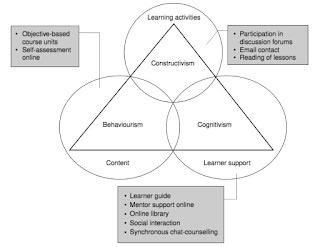This week our group has decided to explore the following question: How do we overcome the uncertainty of the digital world and encourage participation? . This question came out of our discussions from fear of participating (lack of technological skills, fearful of putting work out there for anyone to see and critique, participate…) . Although we are still in the midst of our discussions and inquiry, it is nice to hear each participants experience as a online learning facilitator and as a participants. In our final presentations, I have encouraged our team to share their own digital productions so we can focus on sharing, exchange and constructive feedback and try to move past potential fears together. As we continue to examine the perspectives of both the learner and the facilitator, I have read about Mishra’s Design Framework for Online Learning Environments (2002).

This framework helps us think about online learning from traditional learning theory paradigms and how we design our online courses from these different perspectives. For me this helps alleviate the notion of uncertainty in some ways. As educators we are mostly familiar with traditional learning theories, but now we have to apply this to a new context – online learning. When presented simply like that, it doesn’t make the idea seem impossible, but just a shift in how we present and interact. The online environment lends itself to a more active space for learning and encourages the learner to co-construct his/her own learning, which we see in constructivism. In a traditional classroom, it can be very easy to just show up and be a passive learner. In the online environment we have to work harder to have our voice heard – in forum discussions, through sharing resources, by asking questions, by providing feedback to resources others have shared. The list goes on. The learner in an online environment potentially has more choice to decide how he/she will participate, how often, and how much. For younger students, it is nice to have scaffolding and guide them in a bit more structured way. The idea of the visitor/resident discussion also speaks to this passive vs. active participation. Our students can act as visitors in online courses and we need to move them to learn by encouraging them to participate as residents. In the ONL181 course, we have some structure in the form of the scenario and a few resources to get us thinking about the subject. Then we move into the flexibility to “make the topic our own” and diverge into more specific areas of the topic that interest us while remaining focused on the theme by exploring a question. I am excited to see how we continue with our work this week.